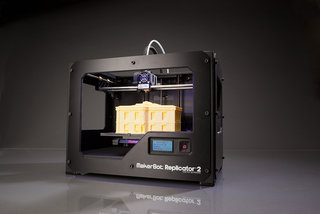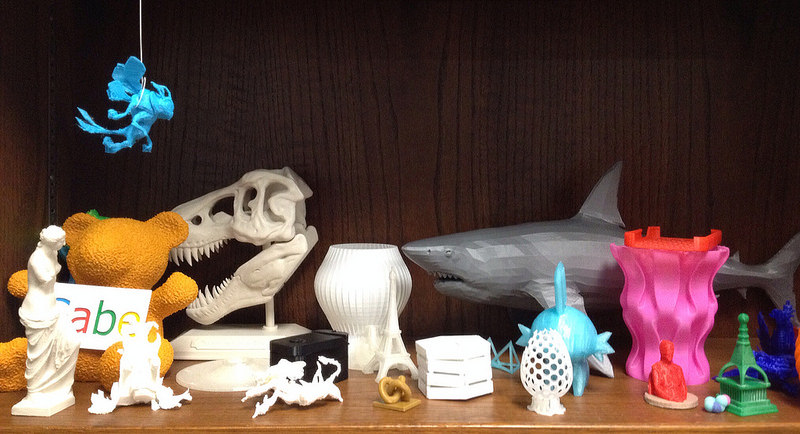Home › Forums › Student forums › Caitlin › Week 9 – Argue a Point: 3-D Printing is not for Libraries
- This topic has 7 replies, 6 voices, and was last updated 8 years, 5 months ago by
Caitlin ..
-
AuthorPosts
-
-
September 20, 2015 at 9:02 pm #2151
Caitlin .
Participant 3-D Printer
3-D Printer
Hugh Rundle makes a very valid argument that libraries should deal in the intangible and that the provision of 3-D printers is a gimmicky leap onto the technology bandwagon. Not true innovation in library programming.
I think perhaps the point that he is missing is the role a 3-D printer could play in creating the intangible. In creating an innovative high tech makerspace which connected to the community and attracted new participants.
The existence of a technified makerspace allows the general public access to new technologies, such as 3-D printers not readily available .A feature of the Brooklyn Library’s “information commons” where they deliberately set out to provide a variety of software for users, allowing them to increase literacy by familiarity and then formal classes. Their space was designed to be both creative and collaborative where all kinds of users could interact with technology to create and design.
Technology based makerspaces can be made relevant to young people already familiar with technology and can been used in conjunction with MineCraft and other gaming days to provide a creative outlet for those used to inhabiting a purely digital realm. Gamers can use printers to design and create model characters and board games from their favorite online worlds.
Digital Literacy and issues arising from access is increasing, forming a key part of a Libraries equity programs in many countries. Technology based makerspaces can be used to fulfill a digital literacy void by keeping the community up to date with changing technologies used increasingly in business and education. They can provide literacy through fun and creativity rather than lecture style software demonstrations more commonly used.
3-D printers can also encourage those traditionally creative to engage with technology in maker spaces. Demonstrating new ways to utilize their creativity, increasing their connection with digital literacy and allowing collaboration with community members not normally associated with.
I believe technologically based makerspaces are simply another way of reaching out to the community, filling the void in digital literacy and creating a space for creativity and community engagement. It can up skill the creative in digital technology and allow the technologically competent a new creative outlet. Importantly it encourages innovative thinking and design that has far reaching ramifications for creative wellbeing and employability.
I think Griffey says it best “Libraries need to not only educate and inform, but inspire and transform.” And while 3-D printers aren’t necessarily for every library their connection to new possibilities, innovation, creative thinking and digital literacy means they cannot be merely overlooked as gimmick. Libraries as Information commons will need to house all kinds of information not just in printed and virtual form but technology in all its forms as a tool for communities to be creative, up to date and self-educating. Possibilities Are Endless
Possibilities Are Endless-
This topic was modified 8 years, 5 months ago by
Caitlin ..
-
This topic was modified 8 years, 5 months ago by
Caitlin ..
-
This topic was modified 8 years, 5 months ago by
Caitlin ..
-
This topic was modified 8 years, 5 months ago by
Caitlin ..
-
This topic was modified 8 years, 5 months ago by
Caitlin ..
-
This topic was modified 8 years, 5 months ago by
Caitlin ..
-
This topic was modified 8 years, 5 months ago by
Caitlin ..
-
This topic was modified 8 years, 5 months ago by
Caitlin ..
Attachments:
You must be logged in to view attached files. -
This topic was modified 8 years, 5 months ago by
-
September 20, 2015 at 10:42 pm #2169
Kirsty Roberts
ParticipantGreat post, Caitlin!
Your point about the use of 3D printers helping improve digital literacy was really interesting and something I certainly agree with. While 3D printers in libraries aren’t a necessity, like you’ve said above, they definitely help create a better space for collaborative learning and opportunities.
-
September 22, 2015 at 3:50 pm #2221
Deborah Fuller
ParticipantInteresting post Caitlin. I am very intrigued to see what the development of 3D printers will bring. I have heard people say that they will be misused for weapons, although I believe and hope they will be primarily used for good. I have read a lot how they will be able to make human body parts from them, which I think will be amazing. I therefore think that making them available in some libraries we are encouraging innovation that can produce astounding results.
-
October 7, 2015 at 6:27 am #2346
Chris Sonneveld
ParticipantHi Caitlin
Thank you for the great post. I completely agree with what you’re saying. I got an opportunity to play with my first 3D printer a few weeks ago and that was through a public library. 3D printers to me are something a tech enthusiast with lots of money would go out and buy. Without having access to one through my local library I don’t know when I would have got to see one, let alone experiment with one. I remember 20 years ago when my father purchased a ridiculously expensive flatbed scanner for work and now I take photos of documents with my phone to scan them into my computer. I can definitely see 3D printing technology in most households within 20 years. Currently there is move to digital away from tangible objects but I think people are starting to realise that tangible is still necessary, you only have to see the popularity of physical books over e-readers.
-
October 9, 2015 at 9:59 pm #2391
Peldon P
ParticipantHi Catlin, you have made some valid arguments regarding the use of 3d printers in libraries for makerspaces. When I hear 3d printer the first thing that comes to my mind is a printout (hardcopy) with images and letters in 3 dimensions. Because of this vision in my head, it was hard for me to analyse its other usage but your post has somehow opened my mind to other possibilities. However, like some of our peers highlighted here, I was also wondering if 3d printers are not too expensive to use for the makerspace programs considering how libraries are mostly low on budget. Cheers. 🙂
-
October 11, 2015 at 2:11 pm #2430
Caitlin .
ParticipantI agree Peldon they are not a necessity and an expensive purchase. However I think they would fit nicely into some out of the box grants and industry partnerships.
-
October 28, 2015 at 9:21 pm #2822
Steven Walker
ParticipantHi Caitlin,
I am of the opposite view , it would be awesome if you could take a look at my twitter chat champion – in here is where i pose a series of questions etc in order to get my pro 3d printing view accross. Morpheuss17 is my user ID
-
November 1, 2015 at 9:40 pm #2933
Caitlin .
ParticipantThanks Steve,
I enjoyed your post and added my thoughts as suggested, although I think my post is actually a little more pro 3-D printers than you assume. While possibly not an absolute I believe they are a valid addition and far more than a gimmick.
Caitlin
-
-
AuthorPosts
- You must be logged in to reply to this topic.